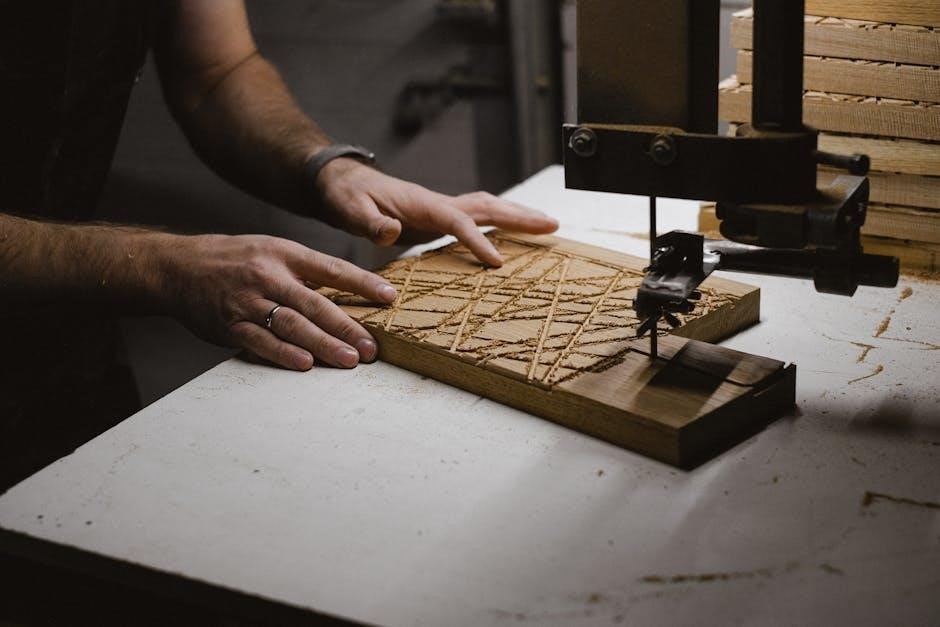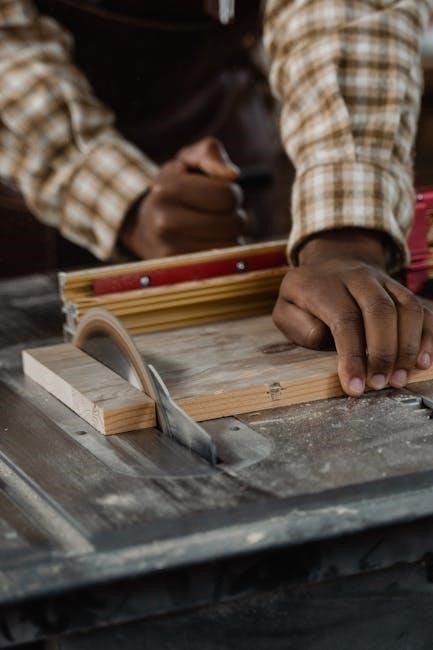
Table saw guide rollers are essential accessories that support workpieces during cutting, enhancing safety and efficiency. They reduce injury risks and prevent kickback, ensuring stable material movement.
1.1 What Are Table Saw Guide Rollers?
Table saw guide rollers are mechanical accessories designed to support and guide workpieces during cutting operations. They consist of rotating cylinders or wheels that help move materials smoothly across the saw. These rollers are typically adjustable in height and position, ensuring proper alignment with the workpiece. They enhance control, reduce friction, and are essential for safe and precise woodworking operations.
1.2 Importance of Guide Rollers in Table Saw Operations
Guide rollers play a crucial role in table saw operations by enhancing safety, efficiency, and precision. They provide stable support for workpieces, reducing the risk of kickback and injuries. Rollers also improve control over materials, especially for long or heavy workpieces, ensuring smooth and consistent cuts. This makes them indispensable for both amateur and professional woodworkers seeking accurate and safe results.

Types of Guide Rollers for Table Saws
Table saw guide rollers come in various types, including infeed, outfeed, and combination systems. Each type serves specific purposes, enhancing workflow efficiency and material support during cuts effectively.
2.1 Infeed Rollers
Infeed rollers are designed to assist in safely and efficiently guiding workpieces into the table saw. They reduce the effort needed to push heavy or long materials, minimizing strain and maximizing control. These rollers are particularly useful for large or unwieldy workpieces, ensuring smooth entry and reducing the risk of accidents during the cutting process;
2.2 Outfeed Rollers
Outfeed rollers provide crucial support for workpieces as they exit the table saw, ensuring smooth and controlled movement. They help prevent kickback and bind, reducing the risk of accidents. These rollers are especially beneficial for managing long or heavy materials, allowing for easier handling and maintaining workflow efficiency during the cutting process.
2.3 Combination Infeed and Outfeed Roller Systems
Combination infeed and outfeed roller systems offer comprehensive support for workpieces throughout the entire cutting process. These systems ensure smooth material flow from start to finish, reducing the risk of kickback and enhancing control. By integrating both infeed and outfeed functionalities, they provide consistent support, making them ideal for handling various materials and project sizes with precision and efficiency.
Safety Considerations with Table Saw Guide Rollers
Guide rollers enhance safety by reducing injury risks and preventing kickback. They stabilize workpiece movement, ensuring smoother cuts and better control during table saw operations.
3.1 Reducing Injury Risks
Table saw guide rollers significantly reduce injury risks by stabilizing workpieces during cuts, preventing sudden movements, and minimizing kickback. They ensure consistent control, reducing the likelihood of accidents caused by uneven or unstable material handling. By securely holding the workpiece in place, rollers lessen the need for excessive force, further enhancing safety and creating a more controlled working environment.
3.2 Preventing Kickback
Table saw guide rollers play a crucial role in preventing kickback by firmly holding the workpiece in place. This consistent contact reduces the likelihood of sudden, dangerous ejections. By maintaining steady control over the material, rollers minimize unpredictable movement, creating a safer cutting environment and reducing the risk of accidents caused by kickback during table saw operations.
3.4 Ensuring Stable Workpiece Movement
Table saw guide rollers ensure stable workpiece movement by maintaining consistent contact and alignment. They prevent uneven pressure that could cause shifting or slipping, allowing for smooth, controlled cuts. This stability enhances accuracy and safety, reducing the risk of misalignment and improving overall cutting performance during table saw operations.

Features to Look for in Table Saw Guide Rollers
Key features include adjustability, durability, and smooth operation. Look for hardened ball-bearing rollers, flexible height settings, and robust materials to ensure long-lasting performance and precise control.
4.1 Adjustability
Adjustability is crucial for optimizing guide roller performance. Look for systems with precise height and tilt adjustments to accommodate various workpiece sizes and materials. Easy-to-use mechanisms ensure quick customization, while some models offer flexible alignment options to enhance setup flexibility. This feature is essential for maintaining consistent contact and ensuring smooth, precise material movement during cutting operations.
4.2 Durability and Material Quality
Durability and material quality are vital for long-lasting performance. High-quality guide rollers are typically made from hardened steel or durable polymers, ensuring resistance to wear and tear. Look for rollers with sealed bearings to minimize friction and extend lifespan. Durable materials also support heavy workloads without compromising stability, ensuring consistent performance over time.
4.3 Smooth Operation and Low Friction
Smooth operation and low friction are crucial for seamless feeding of materials. High-quality guide rollers feature sealed bearings and hardened surfaces, minimizing resistance. This ensures effortless workpiece movement, reducing fatigue and improving control during cutting. Low-friction designs also prevent material dragging, enhancing precision and safety in woodworking tasks.

Installation and Maintenance Tips
Install guide rollers by adjusting their height and securing them firmly. Regularly clean and lubricate bearings to ensure smooth operation and extend longevity.
5.1 How to Install Guide Rollers
To install guide rollers, adjust their height to 1/8 to 1/4 below the workpiece face. Ensure they are level and securely attached to the table or stand. Use a hole saw to create plugs for PVC pipes, then attach the rollers. Clamp the system firmly to sawhorses or stands for stability and proper alignment during cutting operations.
5.2 Maintenance Practices for Optimal Performance
Regularly clean guide rollers to remove dust and debris; Lubricate bearings to ensure smooth operation. Check and tighten all connections to prevent loosening during use. Inspect rollers for wear and replace them as needed. Adjust the height and alignment periodically to maintain accuracy. Proper maintenance ensures consistent performance and extends the lifespan of the guide rollers.

Common Applications Beyond Table Saws
Guide rollers are versatile tools used with planers, sanders, and band saws. They also integrate with cross-cut saws and other woodworking equipment, enhancing workflow and material support.
6.1 Use with Planers and Sanders
Guide rollers are frequently used with planers and sanders to support workpieces during processing. They ensure smooth material movement and consistent results. For planers, rollers help maintain even pressure, reducing uneven surfaces. With sanders, they prevent material wobble, enhancing finish quality. Rollers also integrate seamlessly with these tools, improving overall workshop efficiency and workflow. Their adjustable height and sturdy design make them ideal for various woodworking tasks.
6.2 Integration with Band Saws and Cross-Cut Saws
Guide rollers seamlessly integrate with band saws and cross-cut saws, enhancing material support during cutting. They ensure smooth workpiece movement and precise alignment, reducing vibrations and improving accuracy. For band saws, rollers help manage curved cuts, while for cross-cut saws, they maintain steady material positioning. This integration boosts efficiency and safety, making rollers a versatile tool across various woodworking applications.

Comparison with Other Feeding Systems
Table saw guide rollers outperform other feeding systems by offering smoother operation, better load capacity, and reduced friction. They excel over manual feeding and wheel feeders in precision and efficiency.
7.1 Roller Feeders vs. Wheel Feeders
Roller feeders outshine wheel feeders in handling heavy materials, offering consistent support and smooth operation. Unlike wheel feeders, rollers minimize material marking and slipping, ensuring precise control. Their robust design enhances durability, making them ideal for demanding woodworking tasks. Roller systems also allow easier adjustment, providing superior stability for consistent cuts, especially with large or wide workpieces.
7;2 Advantages Over Manual Feeding
Guide rollers eliminate the need for manual pushing, significantly reducing physical strain and fatigue. They enhance safety by maintaining consistent control over the workpiece, minimizing the risk of accidents. Rollers also improve cutting accuracy and speed, allowing for smoother operations. This makes them particularly beneficial for woodworkers with physical limitations or when handling large, heavy, or unwieldy materials.

Accessories for Enhanced Functionality
Accessories like outfeed tables, roller stands, and height-adjustable systems enhance functionality. They support long workpieces, improve stability, and reduce material movement during cutting, ensuring safer and more precise operations.
8.1 Outfeed Tables and Roller Stands
Outfeed tables and roller stands are indispensable for supporting long workpieces during cutting. They reduce strain and enhance stability, allowing smoother material movement. Height-adjustable designs ensure compatibility with various projects. Sturdy constructions, often featuring ball-bearing rollers, facilitate effortless gliding. Products like the WORKPRO Folding Roller Stand, with a 250 LB capacity and 4.6-star rating, exemplify these benefits, offering reliability and convenience for woodworking tasks.
8.2 Height-Adjustable Roller Systems
Height-adjustable roller systems offer versatility and customization for various woodworking tasks. These systems allow users to tailor the roller position to their project needs, ensuring precise alignment and support. Featuring durable materials and smooth ball-bearing rollers, they enhance safety and efficiency. Adjustable designs accommodate different workpiece thicknesses, making them ideal for both infeed and outfeed applications, while ensuring stable and controlled material movement during cuts.
Table saw guide rollers enhance safety, efficiency, and precision in woodworking. Their benefits, including reduced injury risks and stable workpiece movement, make them indispensable for professionals and hobbyists alike.
9.1 Summarizing the Benefits
Table saw guide rollers significantly enhance woodworking safety and efficiency. They reduce injury risks, prevent kickback, and ensure stable workpiece movement. By providing consistent support, they make feeding lumber safer and easier, especially for those who fear injury or lack the strength to push materials. This results in smoother cuts and reduced fatigue, ultimately improving the overall woodworking experience and precision.
9.2 Final Thoughts on Implementing Guide Rollers
Implementing table saw guide rollers is a practical and beneficial upgrade for any workshop. They enhance safety, reduce physical strain, and improve cut quality. With their versatility and ease of use, guide rollers are a worthwhile investment for both professionals and hobbyists. They not only streamline workflows but also future-proof your setup, ensuring efficient and precise woodworking for years to come.